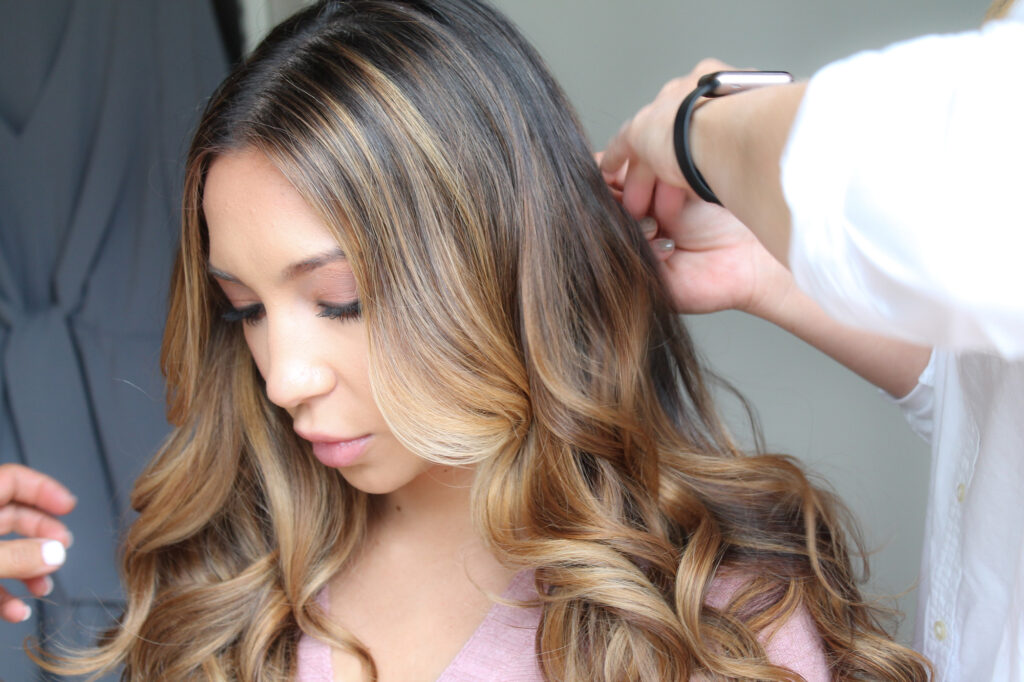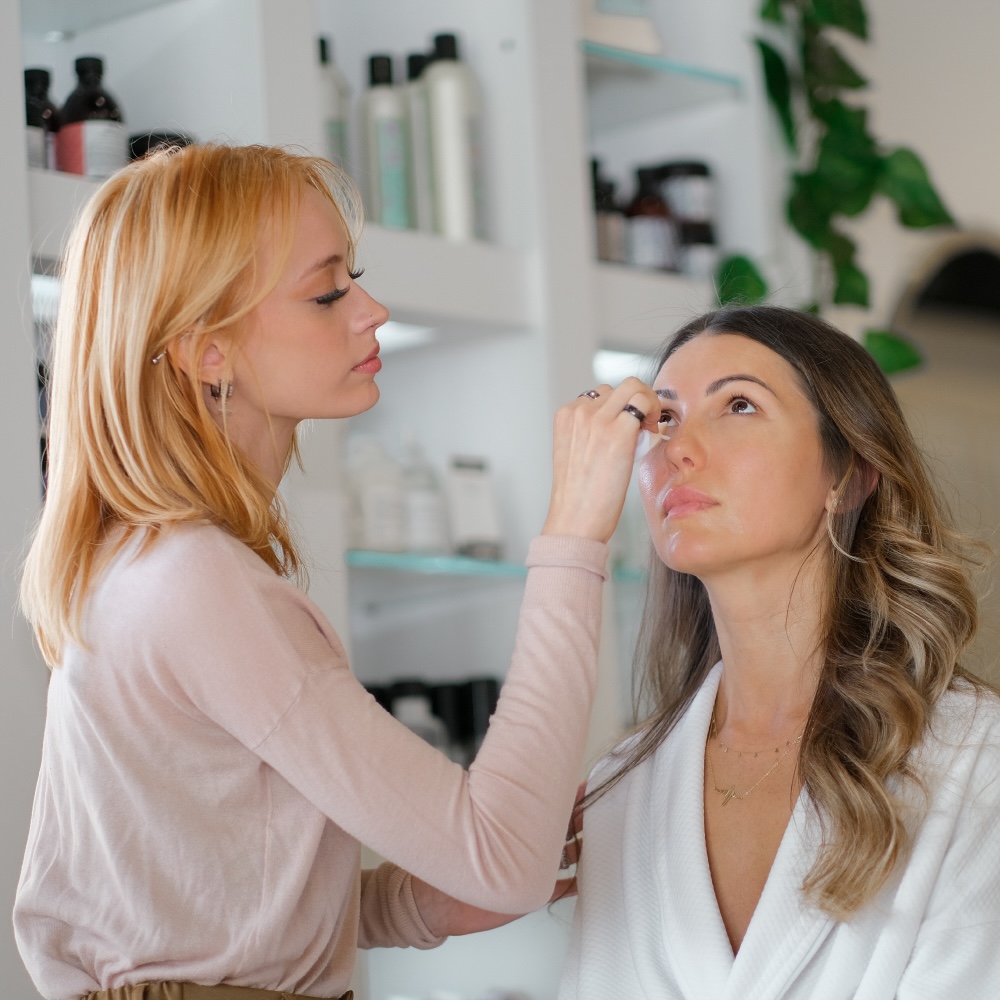
If you have thin hair, there are still plenty of great options out there for hair extensions that can be easily hidden and won’t damage your delicate hair! So whether you want to add density, length, or both, just be sure to do your research and go to a trusted source for hair extensions. In the meantime, keep reading this post to learn more about the best hair extensions for thin hair.
The Best Hair Extensions For Thin Hair
Here are some of the best hair extensions for thin hair that can help give you the look you want without damaging your delicate strands:
Hand-tied extensions
Hand-tied extensions are one of the best options for thin hair because they help reduce any tension on the scalp. They are also less likely to slip out and are very comfortable to wear. Hand-tied extensions are made by tying individual strands of hair too small sections of your natural hair with a special needle. This method is much less invasive than other types of hair extensions and won’t damage your natural hair.
Tape-in hair extensions
Tape-in hair extensions are another good option for those with thin hair. They are less damaging than other types of hair extensions because they don’t require any chemicals or heat to apply them. Tape-in extensions are applied by bonding the wefts to your natural hair with adhesive tape. They can last up to eight weeks, but they should be reapplied every four to six weeks to maintain the bond.
Clip-in hair extensions
Clip-in hair extensions are also an excellent option for those with thin hair. They are easy to put in and take out and don’t require special tools or products. You can find clip-in hair extensions made from real human hair, synthetic fibers, or a mix of both. Real human hair extensions will look the most natural, but they can be more expensive than synthetic fibers.
If you are looking for clip-in extensions, watch for the following features:
- The weft should be made of lightweight hair similar in texture to your own
- The clips should be small, discreet, and flat
- The hair extensions should be the same color as your own hair or slightly lighter
I-tip (individual strand) hair extensions
I-tip hair extensions are individual strands of hair that are attached to your natural hair with small beads. They’re well-suited for those with thin hair because, like tape-in extensions, they don’t require the use of any chemicals or heat.
When choosing i-tip hair extensions, look for the following features:
- The strands should be made of lightweight hair similar in texture to your own
- The beads should be small and discreet
- The hair extensions should be the same color as your own hair or slightly lighter
Micro-ring (loop) hair extensions
Micro-ring hair extensions are similar to i-tip extensions, but the strands are attached to your natural hair with small loops instead of beads. As a result, they are less damaging than other types of hair extensions and can last up to eight weeks.
Halo hair extensions
Halo hair extensions are convenient for those with thin hair because they are easy to put in and take out. They also don’t call for any special tools or products. Halo extension wefts have a clear monofilament band that is meant to be worn around the head like a halo. Then, you pull some of your natural hair over the top of the weft to cover the band.
Caring for Thin Hair
Now that we’ve talked about the best extensions for thin hair, let’s move on to some tips for caring for thin hair and keeping it as strong, healthy, and dense as possible.
Here are some tips for caring for thin hair:
Be gentle with your hair
Being gentle with your hair is essential regardless of how thick or thin it is. But if you have thin hair, you need to be extra careful not to damage your strands. Avoid brushing your hair while it’s wet, and use a wide-tooth comb instead of a brush. When you brush or comb your hair, start from the bottom and work your way up to the top.
Use the right products
Using the right products is important for all hair types but it’s especially vital for thin hair. Look for products that are lightweight and won’t weigh down your strands. Also, avoid products that contain alcohol, as they can dry out your hair and make it more susceptible to breakage.
Limit heat styling
Heat styling is one of the most dangerous things for any type of hair. To avoid damaging your strands, limit heat styling and use the lowest setting possible. If you must use heat styling tools, be sure to use a heat protectant product first.
Let your hair air dry
Air drying is the best way to dry your hair if you have thin strands. If you must use a blow dryer, use the cool setting and hold the dryer at least six inches away from your head.
Eat a healthy diet
Eating a healthy diet is vital for all aspects of your health, including your hair. If you want to keep your hair strong and healthy, make sure to eat plenty of fruits, vegetables, lean protein, and healthy fats.
Styling Tips for Thin Hair
Whether you wear extensions or not, here are some tips for styling thin hair and helping it look its best:
- Get a short haircut: If you have thin hair, you may want to consider getting a short haircut. Short haircuts are easier to style and can help your hair look fuller.
- Add layers: Adding layers is a great way to give your hair some extra volume and texture. If you have thin hair, ask your stylist for some light layers.
- Use the right products: Using the right styling products is essential for all hair types, but it’s crucial for thin hair. Look for volumizing shampoos, conditioners, and styling products that add volume and texture.
- Avoid over-washing: Overwashing your hair can strip it of its natural oils and make it more likely to break. If you have thin or fine hair, you may want to wash it every other day or even every three days.
- Use a diffuser: A diffuser is a handy tool for adding volume and texture to thin hair. When using a diffuser, be sure to use the lowest setting and hold the dryer at least six inches away from your head.
Read more about the best hairstyles for thin hair next.
Hair Extensions: FAQs
Now, let’s answer some frequently asked questions about hair extensions.
Can hair extensions damage thin hair?
While all types of hair extensions can potentially damage your hair, the risk is greater with certain types of extensions. For example, clip-in extensions that are not applied correctly can cause traction alopecia, a type of balding caused by tugging on the hair. If you have thin or fine hair and want to wear extensions, remember to consult a professional stylist to ensure they’re applied correctly and will not damage your strands.
How often should I get my hair extensions replaced?
The frequency with which you need to replace your hair extensions depends on the type of extensions you have and how well you care for them. Generally, micro-ring and i-tip extensions need to be replaced every four to eight weeks, while halo extensions can last for up to six months.
What is the best way to remove hair extensions?
The best way to remove hair extensions depends on the type of extensions you have. A professional stylist should remove micro-ring and i-tip extensions, while halo extensions can be taken off at home. Similarly, clip-in extensions can be removed at home, but it is best to consult with a professional stylist to ensure that they are removed correctly and do not damage your hair.
How much do hair extensions cost?
The cost of hair extensions varies depending on the type of extensions you choose and the length and thickness of the strands. Generally, the longer and thicker the extensions, the more expensive they will be. Halo extensions are typically the most affordable type of extension, while i-tip extensions are on the higher end of the price spectrum.
Keep in mind that the hair’s quality will also play a significant role in the overall cost. For example, if you want to invest in high-quality hair extensions that will last, you can expect to pay anywhere from $100 to $600.
Are hair extensions worth the price?
Hair extensions can be a game-changer for people who want more volume or length—fast! For many people, they’re an invaluable asset and worth every penny. That said, the initial cost can be pricey, so it’s helpful to do your research beforehand and make sure you’re choosing the right type of extensions for your needs.
When it comes to hair extensions, thin hair doesn’t have to be a problem. There are plenty of options out there for people with thin hair, from halo extensions to clip-ins. And with the proper care, you can keep your thin hair healthy and strong.
If you want to learn more about the best hair extensions for thin hair and get help with achieving the hair of your dreams, contact Anushka Salon in West Palm Beach today! We offer Platinum Seamless Hair Extensions—the best on the market—which are hand dyed and hand-assembled. Learn more.
